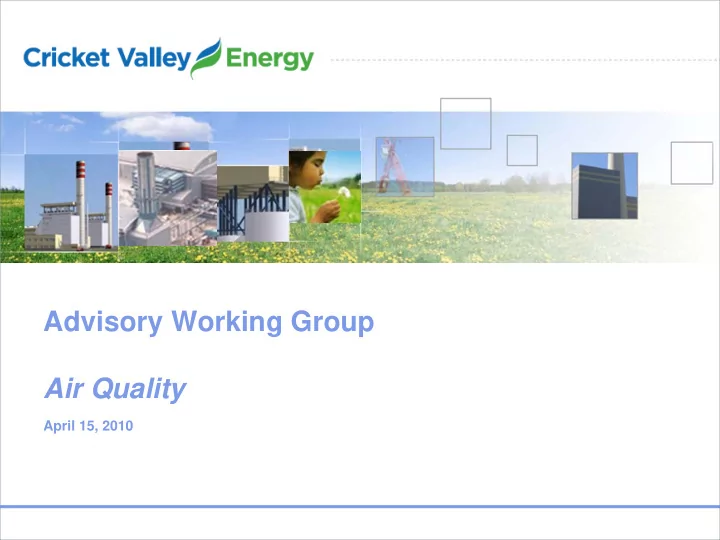

Advisory Working Group Air Quality April 15, 2010
Agenda � Introductions � About Advisory Groups � Air Permit Application � Air Quality Discussion � Q&A � Next Meeting
Air Quality Advisory Group Meeting Recap February 3, 2010 � Provided detailed overview of local and regional air quality � Explained federal and state air quality standards and permitting programs � Described methodology to model potential air quality impacts � Defined topics for tonight’s meeting � Scheduled meeting to follow submission of air quality permit application (March 26, 2010)
What is an air quality permit? � Regulatory document issued by USEPA and NYSDEC that details legally enforceable requirements for a specific facility � Dictates the technology, emissions control equipment and regulations that will apply to a specific facility � Establishes enforceable permit limitations � Specifies monitoring and reporting requirements � Includes NYS requirements needed to protect public health and the environment
What is an air quality permit’s purpose? � Protect public health and welfare � Preserve and enhance air quality � Maintain National Ambient Air Quality Standards (NAAQS) � Ensure economic growth in a manner that preserves clean air resources � Require use of Best Available Control Technology/Lowest Achievable Emission Rate � Require multi-agency evaluation of application prior to permitting � Ensure public participation in the decision-making process
What is the permitting process? 1. Cricket Valley Energy filed an Air Permit Application March 26, 2010 2. NYSDEC and USEPA will analyze the application for strict compliance with state and federal air quality regulations 3. NYSDEC and USEPA will issue draft air permits and will notify the public that the draft permits are available 4. The public will review and comment on draft permits during SEQR process and PSD permit comment period 5. Written comments will be incorporated into the decision making process related to the scope of the permit
What regulations must CVE comply with? � National Ambient Air Quality Standards (NAAQS) � Nonattainment New Source Review (NNSR) � Prevention of Significant Deterioration (PSD) New Source Review � New Source Performance Standards (NSPS) � National Emission Standards for Hazardous Air Pollutants (NESHAP) � Clean Air Interstate Rule (CAIR) � Acid Rain Program (Title IV) � New York State Additional Requirements � Sulfur in fuels � Visible emissions � CO 2 Budget Trading Program � Accidental release requirements
What must the applicant prove to receive a permit? � Project impacts protect the health of the most vulnerable individuals � Complies with National Ambient Air Quality Standards and Prevention of Significant Deterioration Increments � Impact of non-criteria (toxic) pollutants are below health-based guidelines � Contribution to acid rain is insignificant � “Worst-case” hypothetical release of ammonia poses no offsite risk � No significant or disproportionate impact to disadvantaged (Environmental Justice) communities � No significant visibility impact at closest state park/natural resource � No significant effect on soils/vegetation
How do you assess air quality impacts?
Systematic Approach � Collect data from approved regional air quality and meteorology monitoring stations: � Real time hourly meteorological data for approximately 5 years � Most current 3 years of air quality monitoring data � Air quality dispersion modeling for each regulated pollutant � NO 2 , SO 2 , PM 2.5 , PM 10, CO, and over 40 individual air toxics � Compare maximum impacts to appropriate standards and guidelines
Data Resources
Modeling Approach � NYSDEC/USEPA approved modeling protocol and data assumptions � Modeled approximately five years of hourly average meteorological data which were derived from one- minute observations � Calculated impacts at 1,507 receptors covering an 8 km X 8 km area � Maximum permitted emission rate and the full range of operating conditions
What the Data Showed Stack Emissions � 74% nitrogen (N 2 ) � 12% oxygen (O 2 ) � 9% water (H 2 O) � 4% carbon dioxide (CO 2 ) � 1% argon (Ar) � 0.0012% gaseous pollutants � 0.0003% particulate matter
What the Data Showed � Maximum impacts below all USEPA promulgated Significant Impact Levels (SILs) � When added to existing background, well below NAAQS � PM 2.5 impacts above only the most stringent of the proposed SILs
What the Data Showed – PM 2.5 � Maximum PM 2.5 impacts above SILs are limited spatially and temporally � Interactive cumulative PM 2.5 modeling with all major sources within 55 km
What the Data Showed � Project impacts were added to interactive source contributions and highest background concentrations at all receptors where the SIL was exceeded � The cumulative impact of the project, other major sources and background complies with the NAAQS
Conclusions Contained in Permit Application � Impacts on air quality are insignificant and protective of health of even the most vulnerable individuals, including those with asthma and emphysema � Project demonstrates compliance with National Ambient Air Quality Standards, including the cumulative impact analysis for PM 2.5 � Impacts of non-criteria (toxic) pollutants are well below all health-based guidelines � Contribution to acid rain resulting from air quality impacts is insignificant � Modeling of a “worst-case” hypothetical accidental release of ammonia indicates no off-site health risk � No significant or disproportionate impacts to disadvantaged communities � There is no significant visual impact on the nearest park and natural resource: James Baird State Park and the Catskill Mountains � No significant air quality impacts to soils or vegetation
Questions & Contacts Matthew Martin, Associate Project Manager 845-877-0596, mmartin@advancedpowerna.com 5 Market Street, Dover, NY 12522 Bob De Meyere, Project Manager 617-456-2214, bdemeyere@advancedpowerna.com 31 Milk Street, Suite 1001, Boston, MA 02109
Recommend
More recommend